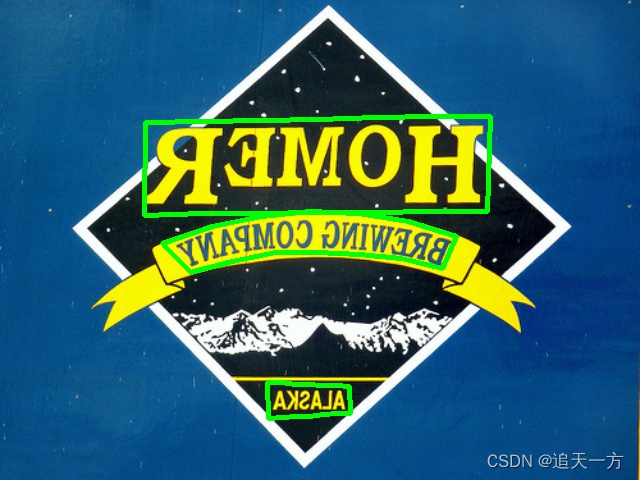前言
突然想总结一下数据增强,这篇博客主要针对于场景文字检测的数据增强,主要是多边形。当然目标检测也是同理,毕竟同样都是点集。
1.ColorJitter
随机调整图像的亮度、对比度、饱和度和色调。这里笔者对torchvision的接口包装了一下:
class ColorJitter(object):
def __int__(self, brightness=0, contrast=0, saturation=0, hue=0):
'''
随机增强brightness, contrast, saturation, hue
:param brightness:
:param contrast:
:param saturation:
:param hue:
:return:
'''
self.transform = transforms.ColorJitter(brightness, contrast, saturation, hue)
def __call__(self, data: dict):
'''
随机增强brightness, contrast, saturation, hue
:param img:rgb图像
:return:numpy.array
'''
img = data.get('img', None)
img = Image.fromarray(img)
img = self.transform(img)
img = np.asarray(img)
data['img'] = img
return data
2.图像的标准化
class Normalize:
def __init__(self, mean, std=None):
'''
标准化
:param mean: list or np.ndarray
:param std:
'''
if not isinstance(mean, np.ndarray):
mean = np.array(mean)
std = np.array(std)
self.mean = mean
self.std = std
def __call__(self, data):
'''
:param img: 输入rgb图片
:return:
'''
img = data.get('img', None)
img -= self.mean
if self.std is None:
return img / 255
img /= self.std
data['img'] = img
return data
3.多边形class
下面的的代码比上面复杂一点,因为接下来这些数据增强涉及到了点集的变换,这里笔者设计了一个多边形class,里面实现了我们需要的点集变换。具体的成员函数会在相应的数据增强代码中给出。
class Polygons_tf(object):
'''
对多边形转换
'''
def __init__(self,polygons:np.ndarray,h,w):
'''
:param polygons: 要处理的多边形,shape:(n,14,2)
:param h:
:param w:
'''
self.polygons=polygons
self.h=h
self.w=w
if len(self.polygons)==0:
raise RuntimeError("No polygons")
def __eq__(self, other):
if isinstance(other,np.ndarray):
self.polygons=other
elif isinstance(other,Polygons_tf):
self.polygons=other.polygons
self.w=other.w
self.h=other.h
else:
raise RuntimeError("can transform "+other)
def value(self):
return self.polygons
4.垂直翻转
垂直翻转即上下翻转了,x坐标不变,然后用图像的高减去原来的y值就是翻转后的了
class RandomVerticalFlip:
'''
垂直翻转
'''
def __init__(self,p):
self.p=p
self.do = False
if np.random.random(1) < self.p:
self.do = True
def __call__(self,data:dict):
if self.do:
img = data.get('img', None)
polys = data.get('polys', None)
# v_img = img[::-1, :, :]
v_img=cv2.flip(img,0)
polys.VerticalFlip()
data['img']=v_img
data['polys']=polys
return data
def __repr__(self):
repr_str=self.__class__.__name__
return repr_str
def VerticalFlip(self):
'''
垂直翻转
:return:
'''
self.polygons[...,1]=self.h-self.polygons[...,1]
5.水平翻转
水平翻转就和垂直翻转相反了,y坐标不变,用图像的宽减去原来的x值即可
class RandomHorizontalFlip:
'''
水平翻转
'''
def __init__(self,p):
self.p=p
self.do=False
if np.random.random(1)<self.p:
self.do=True
def __call__(self, data:dict):
if self.do:
img = data.get('img', None)
polys = data.get('polys', None)
#cv2要快上很多
# h_img = img[:, ::-1, :]
h_img=cv2.flip(img,1)
polys.HorizontalFlip()
data['img']=h_img
data['polys']=polys
return data
def __repr__(self):
repr_str=self.__class__.__name__+'shui'
return repr_str
def HorizontalFlip(self):
'''
水平翻转
:return:
'''
self.polygons[...,0]=self.w-self.polygons[...,0]
6.resize
这里笔者实现的resize注意的是,最后resize的大小不一定是target_shape,因为要达到自适应缩放的效果,笔者在计算resize的wh时用的是两个里面的小的放缩系数,所以会导致长边达不到target_shape的预期,处理的话也很简单,使用后面的pad就行了,其实也就是把自适应缩放分开成了两步。
class resize(object):
def __init__(self, target_shape):
self.target_shape = target_shape
def _resize(self, img):
h, w = img.shape[:2]
th, tw = self.target_shape[:2]
scale = min(th / h, tw / w)
new_shape = (int(w * scale), int(h * scale))
new_img = cv2.resize(img, new_shape, interpolation=cv2.INTER_LINEAR).astype(np.uint8)
return new_img,scale,new_shape
def __call__(self, data: dict):
img = data.get('img', None)
polys = data.get('polys', None)
new_img ,scale,new_shape= self._resize(img)
polys.resize(scale,new_shape)
data['img']=new_img
data['polys']=polys
return data
def __repr__(self):
repr_str=self.__class__.__name__
return repr_str
def resize(self,scale,new_shape):
self.polygons=self.polygons*scale
self.w=new_shape[0]
self.h=new_shape[1]
6.Pad
class Pad(object):
def __init__(self, target_shape, pad_val=(0,)):
self.target_shape = target_shape
self.pad_val = pad_val
def pad_img(self, img):
try:
c = img.shape[2]
assert len(self.pad_val) == img.shape[2]
except:
assert len(self.pad_val) == 1
self.pad_val=np.ones((img.shape[2]))*self.pad_val
h, w = img.shape[:2]
th, tw = self.target_shape[:2]
self.top = int((th - h) / 2)
self.left = int((tw - w) / 2)
self.bottom=th-self.top-h
self.right=tw-self.left-w
pad_img=cv2.copyMakeBorder(img,self.top,self.bottom,self.left,self.right,cv2.BORDER_CONSTANT,self.pad_val)
return pad_img
def process_polys(self,polys):
polygons=polys.polygons
polygons[...,0]=polygons[...,0]+self.left
polygons[...,1]=polygons[...,1]+self.top
polygons[...,0]=np.clip(polygons[...,0],self.left,self.target_shape[1]-self.right)
polygons[...,1]=np.clip(polygons[...,1],self.top,self.target_shape[0]-self.bottom)
polys.polygons=polygons
polys.w=self.target_shape[1]
polys.h=self.target_shape[0]
return polys
def __call__(self, data: dict):
img = data['img']
polys = data.get('polys', None)
pad_img = self.pad_img(img)
new_polys=self.process_polys(polys)
data['img']=pad_img
data['polys'] = new_polys
return data
def __repr__(self):
repr_str=self.__class__.__name__
return repr_str
def pad(self,pad_shape,new_shape):
'''
:param pad_shape: (pad_w,pad_h)
:return:
'''
self.polygons[...,0]+=pad_shape[0]
self.polygons[...,1]+=pad_shape[1]
self.h=new_shape[1]
self.w=new_shape[0]
7.结果展示





文章出处登录后可见!
已经登录?立即刷新
